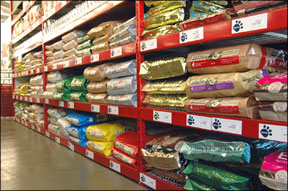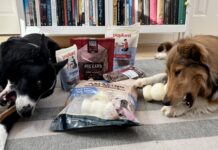What’s the best food for your dog? It’s a question that only you can answer – because you are the only one who is in a position to gauge, on a daily, monthly, and yearly basis, how your dog responds to what you feed him.
That said, we can give you some tips to guide you into the right section of your local pet supply store – that is, past the lowest-cost, lowest-quality foods; past the higher-cost but still low-quality posers; and into the area where the top-quality foods are found. Take note: They are expensive, perhaps prohibitively so, especially for families with several large dogs to feed. But you can’t expect to pay hamburger prices for filet mignon, and it’s the quality (and thus price) of the ingredients that set the top-quality foods apart.

288
Before we tell you what attributes to look for, though, we need to make a few points about the quest for the world’s best dog food:
• Dry food is not the healthiest diet for your dog. If you want to provide the very best, most natural diet possible for your dog, you’d feed a well-researched, home-prepared diet comprised of fresh foods. Or, next best, a well-formulated, commercially made frozen raw or dehydrated diet. Next best would be a top-quality wet food; even poor quality wet foods usually contain a higher percentage of animal protein (and a much lower percentage of grain) than good dry foods.
Of all of these forms of dog food, kibble is probably the least natural for the dog. But its popularity is mainly based on three factors: It is relatively stable and therefore very convenient for the owner to buy, store, and feed. It’s usually less expensive, calorie for calorie, than other forms of food with comparative ingredients. And most dogs do fine on a dry food diet.
Just keep it in the back of your head that if you want your dog to eat the ideal, evolutionary canine diet – because he’s got persistent health problems? because he’s a show or sports competitor and you want an edge? because you’ve lost your last three dogs to cancer and you want to know you did everything possible to give this dog the very best? – you’ll need to look to something other than kibble, even the highest-quality kibble available.
• No food is best all dogs. There is no single diet that works best for all humans, or every individual of any other species, so why people think there might be a single ideal food for every dog is beyond us!
To find the best foods for your dog, you have to try a lot of foods, and make it a point to observe your dog for signs that his diet is or is not agreeing with him. If he has chronic signs of compromised health, such as persistently goopy or runny eyes; infected or smelly ears; inflamed, itchy skin; severe gas; or frequent diarrhea, and these conditions improve, well, hurray! If these things worsen, try another food.
We strongly recommend that you keep some sort of diet journal – at a minimum, with notes on the calendar – to keep track of what foods you feed your dog, and what his response to each product has been. We keep a journal of health- and training-related events in our dog’s life, and note the date each time we open a new bag of food. We store dry food in its original bag until it’s all consumed, but once it’s empty, we cut out the ingredients list, “guaranteed analysis,” and date/code from the bag and tape these bits of packaging into the dog’s journal. This sort of journal can help you identify foods or even individual ingredients that are problematic for your dog; in case of a pet food disaster, it can also help prove what your dog ate, and when he ate it.
• Switch foods regularly. We know; you heard that you shouldn’t switch your dog’s food, or his stomach will get upset. If you ate only one food every day for weeks and months, and then ate something else, your stomach would get upset, too. But very few people eat a diet that never varies from day to day. Human nutrition experts agree that a well-balanced, varied diet is critical for human health; so why do so many people believe that variety is bad for dogs?
Say your dog eats one food, day after day, year after year. And say that food contains a little more of this mineral than is ideal, or not quite enough of that vitamin, or an unhealthy ratio of this nutrient to that one . . . Over time, lacking any other foods to help correct the excesses, insufficiencies, or the imbalances, these problems can contribute to the development of disease.
When you switch your dog’s food, do it gradually, over a couple of days. Start with 75 percent of the old food and 25 percent of the new food at one meal; slowly increase the amount of new food (and decrease the amount of old food) over a few days, until he’s eating only the new food. Try different varieties, as well as products from different companies. If you change foods often, your dog will adjust more and more smoothly.
One more thing: Don’t feed foods comprised of exotic proteins (such as rabbit, kangaroo, bison, pheasant, etc.) if your dog does well on the more common proteins (such as beef, lamb, chicken, and turkey). It’s extremely useful to have a few completely novel proteins held in reserve for use in an “elimination diet” (in which you feed him a diet comprised of, usually, a single novel protein and a single novel grain) in case your dog ever develops a food allergy.
What to look for
Keeping the previous principles in mind (kibble is not the most ideal diet; no food works for all dogs; you should switch foods regularly), you are now ready to look for a few good foods for your dog. Top-quality dry dog foods can be identified by the following hallmarks of quality on their ingredients panels:
• Animal protein at the top of the ingredients list. Animal proteins are more palatable and are of a higher biologic value to dogs than plant-sourced proteins. Ingredients are listed by weight, so ideally a food will have one or two animal proteins in the first few ingredients.
The animal protein source should be named – chicken, beef, lamb, and so on. “Meat” and “animal protein” are examples of low-quality protein sources of dubious origin. Animal protein “meals” (i.e., “chicken meal,” “beef meal,” “lamb meal,” etc.) should also be named; “meat meal” could be just about anything.
Whole meats do not contain enough protein to be used as the sole protein source in a dry dog food. Whole meats contain as much as 65 to 75 percent water and about 15 to 20 percent protein. When a whole meat appears high on the ingredients list, generally another source of protein is also present, in order to augment the total protein content of the finished food. We prefer to see animal protein meals, rather than plant proteins, fill this role.
An animal protein “meal” is essentially cooked and dried (rendered) muscle meat, although a certain amount of bone, skin, and connective tissue is included. Animal protein meals are dried to a moisture level of only about 10 percent, and contain about 65 percent protein.
• Whole vegetables, fruits, and grains. Fresh, unprocessed food ingredients contain wholesome nutrients in all their naturally complex glory, with their fragile vitamins, enzymes, and antioxidants intact. They are also less likely to be adulterated with impurities of any kind.
That said, formulators often use a concentrated (processed) constituent of a grain or vegetable to accomplish a specific task in a dog food. For example, beet pulp is frequently used in dog food for its ability to concentrate the dog’s solid waste (resulting in smaller and firmer poop). We’d rather see whole ingredients used for this purpose, but one or two food fragments won’t make or break the quality of the food, especially if they are lower on the ingredients list. The more of them there are in the food, and/or the higher they appear on the ingredients list, the lower-quality the food.
• Organic ingredients; locally sourced ingredients. Both of these things are better for our planet. Organic ingredients may be especially appropriate for dogs with cancer, chemical sensitivities, or other serious health problems, but holistic practitioners recommend them for all creatures.
What to look out for
Here are some of the things a top-notch food should not contain:
• Meat by-products or poultry by-products. Some non-muscle parts of food animals (i.e., the internal organs) are highly nutritious – in some cases, higher in protein and fat, as just two nutrient examples, than muscle meats. But there are many other parts of food animals that have much less nutritional value – and are worth so much less (in dollars) to the processor, that they are considerably less carefully harvested, handled, processed, and stored.
Poorly handled meats (which contain fat) and fat sources can quickly become rancid. Rancid fats not only smell noxious and taste bad, they also speed the destruction of vitamins and other nutrients in a food. Worst, rancid fats are carcinogenic. ‘Nuff said?
In contrast, whole meats are expensive – too valuable to be handled carelessly. Their cost doesn’t rule out poor handling and resultant oxidation (rancidity), but it makes it less likely. So, for all these reasons, we suggest avoiding foods that contain by-products or by-product meal.
• Added sweeteners. Dogs, like people, enjoy sweet foods. Sweeteners effectively persuade many dogs to eat foods comprised mainly of grain fragments (and containing little of the animal protein that would be healthier for them).
• Artificial preservatives, such as BHA, BHT, and ethoxyquin. Natural preservatives, such as tocopherols (forms of vitamin E), vitamin C, and rosemary extract, can be used instead. Preservation is necessary to keep the fats in the food from oxidizing and turning rancid. Natural preservatives do not preserve the food as long as artificial preservatives, however, so owners should always check the “best by” date on the label and look for relatively fresh products.
• Artificial colors. The color of the food makes no difference to the dog; these nutritionally useless chemicals are used in foods to make them look appealing to you!
Representative “top foods”
Starting on the next page is our “top dry foods” list for 2009. All of these products meet our selection criteria – including our newest criterion, that the company discloses the name and location of its manufacturers. There are certainly more products that both meet our criteria, as described above, and whose makers are willing to answer questions about their manufacturers. Rest assured that any food that you find that meets our selection criteria is just as good as any of the foods on our list.
What if your favorite dog foods don’t meet our selection criteria? It’s up to you. If you have been feeding what we would consider to be low-quality foods to your dog, and she looks and appears to feel great, good for you! She’s one of those genetically lucky animals who can spin straw into gold, digestively speaking. But if she has allergies, chronic diarrhea, recurrent ear infections, or a poor coat, we’d recommend that you try some better foods.
Please note: We’ve listed the foods alphabetically, by the name of their manufacturers. Some companies make several lines of food. We’ve listed each line and each variety that we found that meets our selection criteria. We’ve highlighted one variety from each company as a representative product, to show what sort of ingredients and macro-nutrient levels (protein, fat, fiber, and moisture) are typically found in that maker’s foods. Be aware that some companies offer dozens of different products with varying nutrient levels and ingredients. Check the company’s website or call its toll-free phone number to get information about its other varieties.






